Castle-Manor House of the Week - Bamburgh Castle, Northumberland
September 12, 2012
Bamburgh Castle
Bamburgh, Northumberland, England, UK
OS Grid Reference: NU 183351
Maintained by the Armstrong family
Website(s): www.bamburghcastle.com
(This castle was also featured on this blog on December 13, 2010 after my trip to the UK.)
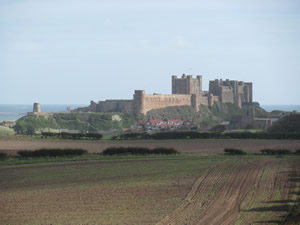 Bamburgh Castle, located on the coast of Northumberland, has a rich and varied history. The first established settlement on the basalt outcrop where the castle stands today belonged to the Votadini tribe around 800 BC. The sight was a natural choice for a fortress, as the crag rose 150 feet above the surrounding area and sea. When the Romans invaded Britain and marched north into Scotland in AD43, they captured Bamburgh, using it as a beacon to warn of seaborn raiders even after the majority of the army retreated south behind Hadrian’s Wall. The Romans abandoned it around the year 410. Bamburgh Castle, located on the coast of Northumberland, has a rich and varied history. The first established settlement on the basalt outcrop where the castle stands today belonged to the Votadini tribe around 800 BC. The sight was a natural choice for a fortress, as the crag rose 150 feet above the surrounding area and sea. When the Romans invaded Britain and marched north into Scotland in AD43, they captured Bamburgh, using it as a beacon to warn of seaborn raiders even after the majority of the army retreated south behind Hadrian’s Wall. The Romans abandoned it around the year 410.
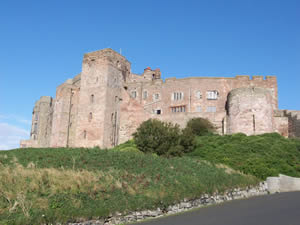 From c. 420 until 547, the sight became a fort for the native Britons, and may have even been their citadel. However, in 547 the first written reference to the castle of Bamburgh was recorded when the Anglo-Saxon ruler Ida of Bernicia, known as Ida the Flambearer, captured it and made it into his royal capital. Of the seven kingdoms that made up Anglo-Saxon England, Bernicia was the largest and most powerful. The wooden stronghold was called Din Guayrdi. From c. 420 until 547, the sight became a fort for the native Britons, and may have even been their citadel. However, in 547 the first written reference to the castle of Bamburgh was recorded when the Anglo-Saxon ruler Ida of Bernicia, known as Ida the Flambearer, captured it and made it into his royal capital. Of the seven kingdoms that made up Anglo-Saxon England, Bernicia was the largest and most powerful. The wooden stronghold was called Din Guayrdi.
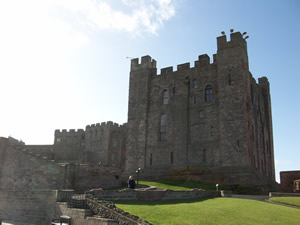 Upon Ida’s and his son Hussa’s passings, the fortress came under the control of Ida’s grandson Aethelfrith around 607. Aethelfrith was notoriously blood-thirsty, and likened to a “ravening wolf” by the Venerable Bede, a monk and the first English historian. His trail of destruction earned Aethelfirth the additional monicker of Flesaurs, which means “Destroyer.” He passed the fortress on to his wife Bebba, for whom it was renamed Bebbanburgh, from which the current name Bamburgh originated. Upon Ida’s and his son Hussa’s passings, the fortress came under the control of Ida’s grandson Aethelfrith around 607. Aethelfrith was notoriously blood-thirsty, and likened to a “ravening wolf” by the Venerable Bede, a monk and the first English historian. His trail of destruction earned Aethelfirth the additional monicker of Flesaurs, which means “Destroyer.” He passed the fortress on to his wife Bebba, for whom it was renamed Bebbanburgh, from which the current name Bamburgh originated.
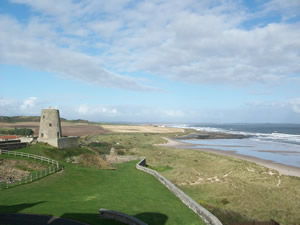 From 610 – 700, the wooden huts were replaced by a royal palace, and was described as being “a most strongly fortified city.” In 634, King Oswald became Northumbria’s Saint King, asking the abbot of Iona to send a bishop so that he might convert his people to Christianity. This bishop, Aidan, was given land on Lindisfarne, a tidal island within view of the citadel of Bamburgh, to build a monastery, which soon becomes the center of learning, art & Christianity in all of Europe. Legend says that during an act of goodness and charity, Aidan blessed Oswald’s right hand, saying, “May this hand never perish.” When Oswald was killed in battle in 642, his men brought his head and arms back to the Basilica of St Peter, Bamburgh’s church. Oswald’s right hand was known by the Celts as Oswald’s Fair-hand, and was said to never have decayed. From 610 – 700, the wooden huts were replaced by a royal palace, and was described as being “a most strongly fortified city.” In 634, King Oswald became Northumbria’s Saint King, asking the abbot of Iona to send a bishop so that he might convert his people to Christianity. This bishop, Aidan, was given land on Lindisfarne, a tidal island within view of the citadel of Bamburgh, to build a monastery, which soon becomes the center of learning, art & Christianity in all of Europe. Legend says that during an act of goodness and charity, Aidan blessed Oswald’s right hand, saying, “May this hand never perish.” When Oswald was killed in battle in 642, his men brought his head and arms back to the Basilica of St Peter, Bamburgh’s church. Oswald’s right hand was known by the Celts as Oswald’s Fair-hand, and was said to never have decayed.
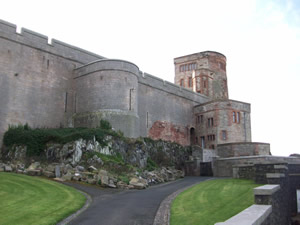 The years 700 – 800 were marked by invasion and violence among the rival Anglo-Saxon kingdoms. In 993, Vikings viciously raided and ransacked Bamburgh, and the kingdom and settlement went into decline. William the Conqueror and his men seized Bamburgh in 1066, using it as a base during their invasions in Scotland. In 1095, William II, also known as William Rufus or the Red King, laid seige to Bamburgh, which was under the control of Robert de Mowbray, the Earl of Northumbira, who had supported a revolt against the king. When Mowbray was captured, his wife, Matilda, and son continued to hold the stronghold against the king. But when William threatened to blind Mowbray, Matilda surrendered. The years 700 – 800 were marked by invasion and violence among the rival Anglo-Saxon kingdoms. In 993, Vikings viciously raided and ransacked Bamburgh, and the kingdom and settlement went into decline. William the Conqueror and his men seized Bamburgh in 1066, using it as a base during their invasions in Scotland. In 1095, William II, also known as William Rufus or the Red King, laid seige to Bamburgh, which was under the control of Robert de Mowbray, the Earl of Northumbira, who had supported a revolt against the king. When Mowbray was captured, his wife, Matilda, and son continued to hold the stronghold against the king. But when William threatened to blind Mowbray, Matilda surrendered.
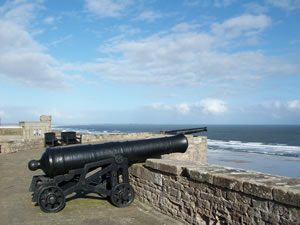 In 1131, refortification of Bamburgh began, to ready it to defend England from the Scots to the north. Because of the hostility between England and Scotland, and the proximity of Northumbria to its enemy, more castles and strongholds can be found in that part of England than anywhere else, and most were built between the 11th and 15th centuries. The Great Tower, or Keep, which is still the heart of the Bambrugh Castle today, was erected from red sandstone in 1164. It was virtually impenetrable from attack and visited by many kings. Bamburgh was also used to keep hostages and prisoners in its dungeon, though higher-ranking prisoners, such as the wounded Scot’s King, David Bruce were held in high status apartments. In 1131, refortification of Bamburgh began, to ready it to defend England from the Scots to the north. Because of the hostility between England and Scotland, and the proximity of Northumbria to its enemy, more castles and strongholds can be found in that part of England than anywhere else, and most were built between the 11th and 15th centuries. The Great Tower, or Keep, which is still the heart of the Bambrugh Castle today, was erected from red sandstone in 1164. It was virtually impenetrable from attack and visited by many kings. Bamburgh was also used to keep hostages and prisoners in its dungeon, though higher-ranking prisoners, such as the wounded Scot’s King, David Bruce were held in high status apartments.
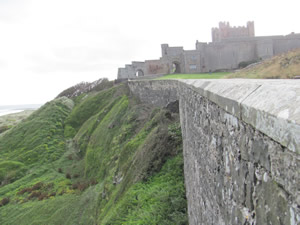 In 1221, Henry III ordered a Great Hall to be built separate from the keep, and began to add improving comforts to the buildings, such as glass windows and chimneys. In 1403, during a time when the castle was under constant threat from the Scots, the control and defence of Bamburgh was given to Henry Percy, aka Henry Hotspur, who was immortalized in Shakespeare’s Henry IV Part One. However, during the War of Roses, in 1464, Bamburgh has the dubious distinction of being the first English castle to be defeated by artillery after a nine-month siege by Richard Neville, the Earl of Warwick, who was trying to capture King Henry VI inside. Bamburgh was never used as a fortress again. In 1221, Henry III ordered a Great Hall to be built separate from the keep, and began to add improving comforts to the buildings, such as glass windows and chimneys. In 1403, during a time when the castle was under constant threat from the Scots, the control and defence of Bamburgh was given to Henry Percy, aka Henry Hotspur, who was immortalized in Shakespeare’s Henry IV Part One. However, during the War of Roses, in 1464, Bamburgh has the dubious distinction of being the first English castle to be defeated by artillery after a nine-month siege by Richard Neville, the Earl of Warwick, who was trying to capture King Henry VI inside. Bamburgh was never used as a fortress again.
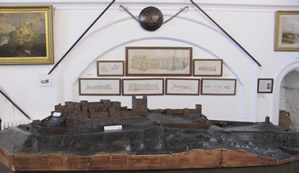 In 1610, the castle was officially abandoned as a royal residence after 1200 years, and given by James I to Claudius Forster to be privately owned. The family was unable to afford the massive cost of Bamburgh Castle’s upkeep, and it fell into ruin. In 1701, Dorothy, the Forster heir, died, and her grieving husband, Bishop of Durham Lord Nathaniel Crewe set up a trust fund in her memory to restore her beloved Bamburgh Castle and support its villagers. The interesting brother and sister pair of Tom & Dorothy Forster, the first Dorothy’s great nephew and niece, lived in Bamburgh in 1715. Tom went off to fight with the Jacobites during the 1715 Rebellion, and was made a General. When he was captured and imprisoned in London, his sister rode all the way there to rescue him. During her visits to see him in the jail, she always took her maid. But on the last visit she did not, secreting the maids clothes beneath her own, and dressing Tom in them when the guards changed shifts. The pair walked out unimpeded. Portraits of them still hang in the castle. In 1610, the castle was officially abandoned as a royal residence after 1200 years, and given by James I to Claudius Forster to be privately owned. The family was unable to afford the massive cost of Bamburgh Castle’s upkeep, and it fell into ruin. In 1701, Dorothy, the Forster heir, died, and her grieving husband, Bishop of Durham Lord Nathaniel Crewe set up a trust fund in her memory to restore her beloved Bamburgh Castle and support its villagers. The interesting brother and sister pair of Tom & Dorothy Forster, the first Dorothy’s great nephew and niece, lived in Bamburgh in 1715. Tom went off to fight with the Jacobites during the 1715 Rebellion, and was made a General. When he was captured and imprisoned in London, his sister rode all the way there to rescue him. During her visits to see him in the jail, she always took her maid. But on the last visit she did not, secreting the maids clothes beneath her own, and dressing Tom in them when the guards changed shifts. The pair walked out unimpeded. Portraits of them still hang in the castle.
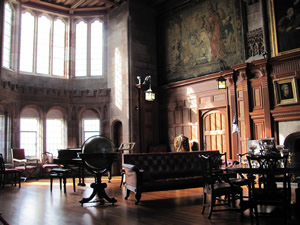 In 1757, Dr John Sharp took control of the Crewe Trust and began to restore the castle, as well as make improvements in the village and the villagers’ lives. Because of the numerous wrecks caused offshore among hidden reefs, in 1781, Dr. Sharp created an extensive coastguard system, believed to be the first of its kind, using the castle as the coastguard station. However, despite his improvements, the castle began to fall into decline again, and needed to be sold. In 1757, Dr John Sharp took control of the Crewe Trust and began to restore the castle, as well as make improvements in the village and the villagers’ lives. Because of the numerous wrecks caused offshore among hidden reefs, in 1781, Dr. Sharp created an extensive coastguard system, believed to be the first of its kind, using the castle as the coastguard station. However, despite his improvements, the castle began to fall into decline again, and needed to be sold.
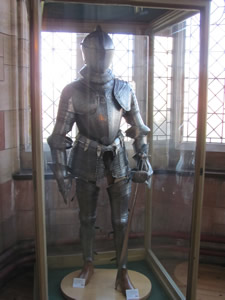 In 1894, Bamburgh was finally bought by Victorian industrialist and inventor, Lord Armstrong from Newcastle. He restored and made extensive improvements to the castle, including fitting central heating and air conditioning, but died in 1900 before seeing it finished. His great nephew, the 2nd Lord Armstrong completed the work, and made the castle into a family residence that is still used today. It is now open to the public for visitation, and used for weddings and corporate events. The castle has also been used in movies since the 1920s, and is featured in such films as Huntingtower (1927), Ivanhoe (1952), El Cid (1961), The Devils (1971), Mary, Queen of Scots (1972), Elizabeth (1998), Revelation (2001), and Robin Hood (2010). In 1894, Bamburgh was finally bought by Victorian industrialist and inventor, Lord Armstrong from Newcastle. He restored and made extensive improvements to the castle, including fitting central heating and air conditioning, but died in 1900 before seeing it finished. His great nephew, the 2nd Lord Armstrong completed the work, and made the castle into a family residence that is still used today. It is now open to the public for visitation, and used for weddings and corporate events. The castle has also been used in movies since the 1920s, and is featured in such films as Huntingtower (1927), Ivanhoe (1952), El Cid (1961), The Devils (1971), Mary, Queen of Scots (1972), Elizabeth (1998), Revelation (2001), and Robin Hood (2010).
The Great Hall has on display numerous works of art, while suits of armor and medieval artifacts are showcased in the basement, along with the dungeon. Most of the castle still feels very much lived in, as it is, with family portraits and knickknacks.
On sight, in one of the castle’s converted outer buildings, is the Armstrong Museum, which exhibits the inventions of the industrialist family and their company Armstrong Whitworth. The displays include engines, artillery and weaponry, as well as aviation artifacts from the two world wars. Also on sight is the roped off area of the Bamburgh Research Project, an ongoing archaeological dig started in 1996. Previous archeological excavations have yielded great finds, including the gold plaque known as the Bamburgh Beast, and the Bamburgh Sword, both found in the 1960s.
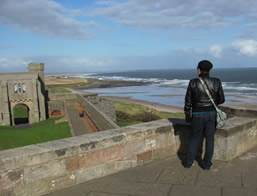 The area surrounding the castle is also gorgeous, with rolling sand dunes and walking paths that lead down to the sandy stretch of beach below the castle. From the castle’s walls, visitors can see the Farne Islands in the distance. Another attraction in the village of Bamburgh is the Grace Darling Museum, dedicated to the bravery of the 23-year-old woman who rowed out with her father, the keeper of the Longstone lighthouse, through treacherous seas to rescue nine people from the wreckage of the Forfarshire steamboat in 1838. The area surrounding the castle is also gorgeous, with rolling sand dunes and walking paths that lead down to the sandy stretch of beach below the castle. From the castle’s walls, visitors can see the Farne Islands in the distance. Another attraction in the village of Bamburgh is the Grace Darling Museum, dedicated to the bravery of the 23-year-old woman who rowed out with her father, the keeper of the Longstone lighthouse, through treacherous seas to rescue nine people from the wreckage of the Forfarshire steamboat in 1838.
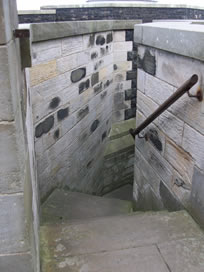 The castle is reputed to be haunted by several ghosts. The Pink Lady was said to have been a Northumbrian princess who when told her love had married another threw herself off the battlements to her death. She returns every seven years to wander the castle and then out to the beach to stare across the sea, looking for her lost love. Another ghost, Green Jane, was said to have come to the castle to beg for food for her starving family, and either tripped or was pushed down the perilous Miller’s Nick steps, and was killed along with the baby in her arms. This scene plays out on steps at the castle, but when people rush to her aid there is no one there. Dr John Sharp is also said to haunt the grounds, never wanting to leave the place he so loved. The castle is reputed to be haunted by several ghosts. The Pink Lady was said to have been a Northumbrian princess who when told her love had married another threw herself off the battlements to her death. She returns every seven years to wander the castle and then out to the beach to stare across the sea, looking for her lost love. Another ghost, Green Jane, was said to have come to the castle to beg for food for her starving family, and either tripped or was pushed down the perilous Miller’s Nick steps, and was killed along with the baby in her arms. This scene plays out on steps at the castle, but when people rush to her aid there is no one there. Dr John Sharp is also said to haunt the grounds, never wanting to leave the place he so loved.
For more information, please visit the castle’s excellent website, www.bamburghcastle.com, which features an interactive virtual tour and extra content, such a legends and myths, and ghost stories. |